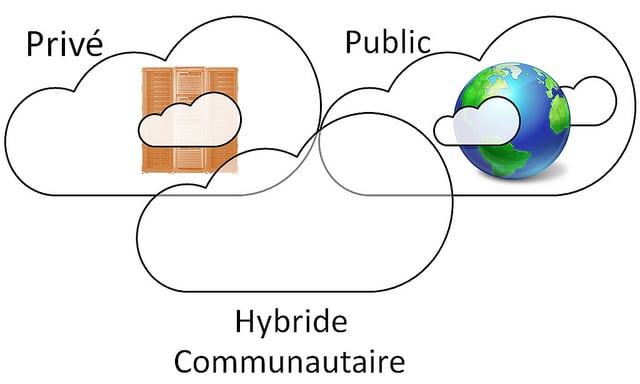Cloud computing is composed of an assortment of layered components, beginning at the most basic physical layer of server infrastructure and storage and moving up through the network and application layers. By a large extent, the cloud is categorized based on implementation models, which include Private, Public, and Hybrid clouds.
All these levels are found within the domains of infrastructure, content, and information cloud with each one of them having their unique characteristics. Aside from security and privacy, it is their uniqueness that influence the consideration factors for their implementation in cloud computing. Therefore, most users and enterprise now manage and control their application across manifold environments in an intricate IT architecture.
As a result, users often end up constantly revising their unique combination of public, private, and on-premises infrastructure to meet new business objectives and establish cost-effective means of cloud migration. The following section gives a brief definition of each of these different options and then discusses them into details.
Different Layers of Cloud Computing
Table of Contents
-
Public Cloud
A public cloud is represented by a system whereby the infrastructure and services offered are off-site over the internet by a provider. Put differently, there is no local physical infrastructure and access to all applications and data is external. The majority of organizations opt for public cloud because of their low and predictable cost of ownership and the rising need of moving from capital expenditure to an efficient operating expenditure.
As an outcome, organizations and business can incredibly reduce initial investment costs and continuing costs of IT labor. They are inexpensive because all the resources including the applications, bandwidth and hardware costs are covered by the provider. The public cloud also comes with technical benefits namely: automated updates and deployments, scalability and greater reliability.
However, the public cloud has a number of technical limitations that can prove futile for some organizational or business needs. For instance, moving some specialized infrastructure to the public cloud may not be possible and if possible, it can be at high risk of breach and security threats. Nonetheless, public cloud service providers can provide and maintain the entire cloud infrastructure such as application and web servers, and can also integrate with on-premise or private cloud solutions.
Example of public cloud providers are Windows Azure Services Platform, IBM’s Blue Cloud, Google AppEngine, and Amazon Elastic Compute Cloud (EC2). The benefits of public cloud systems include:
- Long-term storage, which is considerably more cost-effective solutions than private and hybrid storage
- Can manage data storage of any kind, particularly in terms of physical media on the basis of low-cost storage resource
- Provide web services that are latency-intolerant or mission-critical with scaling capabilities and automated deployments
- Provides for testing environment, owing to the fact that it’s very easy to spin up and down events for load testing
-
Private Cloud
A private cloud is represented by a system whereby the infrastructure and services are managed on a private network. In most cases, the infrastructure and services are within the company’s data center, but run by a third party over the internet. The primary feature of private cloud is that only the company owning the private cloud has overall service access including all hardware and application levels.
All resources are devoted to one customer. For businesses or individuals seeking to advance their business spectrums and gain more competitive advantage, the private cloud is 100% rewarding. Besides, it’s logistically a lot simpler to migrate from on-premises environment to a private cloud compared to moving from on-premises to public cloud.
However, private cloud is not an option for the typical small to medium sized business as it is mostly suited for large businesses with high compliance and security concerns. Enterprises that prefer private cloud are mostly motivated by the fact that they want to keep their assets within the firewall.
Particularly, private cloud is a decent alternative if specific features in legacy applications make it impossible for some applications to run smoothly in the public cloud. Private cloud systems can be set up to support any application including server and network maintenance, application infrastructure, and storage. Examples of private cloud providers include Cisco, IBM, and HP.
Here are some of the reasons that may deem resorting to private cloud a necessity:
- You are using shared storage and need dedicated infrastructure for compliance
- There is increased need for high performance access to file/data systems, especially for heavy media companies that produces lots of video files
- You need high lead time efficiency that cannot be realized within the public cloud environment
- There is need for higher scalability, large storage and a non-predictable usage pattern
- There is need for application stability and smooth running of server as well as applications when there is heavy traffic.
- When there heavy IT infrastructure and it’s management is a priority but the current IT staff are unfamiliar with the applications
-
Hybrid Cloud
A hybrid cloud is simply a combination of private and public cloud. Some of the hybrid cloud elements are outsourced either externally or internally, but not all. Most enterprises say they prefer going for hybrid cloud solutions because of its enterprise infrastructure. By using hybrid cloud, enterprises can control and manage internally administered private cloud while enjoying the benefits of public cloud.
For example, some applications can be moved to the public cloud during peak periods. This can also be applicable and highly beneficial during unforeseen outages such as blackouts or natural disasters, and during scheduled server maintenance periods. Additionally, it is suitable for maintaining an off-premise disaster recovery site, which allows organizations to get back online quickly. Hybrid cloud is highly preferable because it can support a single application that includes on-premises, private or public infrastructure.
This type of cloud layer is mainly suitable for large and sophisticated enterprises that have a necessity of exploring the scalability and flexibility of the public cloud and even across clouds. Even a careful investigation will not fully determine how an application will perform in the public cloud and as such, enterprises prefer to test a single tier in the public cloud while keeping vital infrastructure on their dedicated infrastructure or private cloud.
Similar to the private cloud, enterprises resort to hybrid cloud so as to strengthen their security for sensitive data. Furthermore, the utilization of hybrid cloud can aid in retaining competent IT workers and legacy applications on legacy infrastructure while adopting new lines of service within the cloud environment. This puts in place cost-effective solutions that equally deal with business risks.
Overall, the most fundamental consideration is that hybrid cloud environments are only as functional as the integrations that merge them. Nevertheless, hybrid cloud is still subject to regular testing and performance monitoring to reveal its related difficulties and challenges, which may help in strengthening its application in the future.





